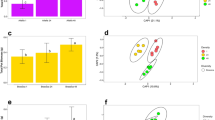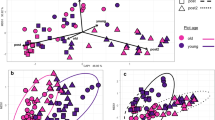Abstract
Populations of bacteria (Pseudomonas fluorescens A506 and Streptomyces sp. strain 93) applied to a creeping bentgrass/annual bluegrass fairway turf were followed over time on leaves and thatch. While introduced populations remained at detectable levels over a period of 11–25 days, they usually declined gradually and did not increase after their application to turf. Streptomyces rapidly disappeared from leaves while P. fluorescens was able to maintain similar population sizes on both thatch and leaves, after an initial decline of about 1-log unit, showing that it was actively colonizing the foliage despite loss of biomass from lawn mowing. Throughout these experiments, populations of indigenous microbes on foliage and thatch remained stable, about 106 and 108 cfu g−1 for fungi and bacteria, respectively, and were not affected by the application of bacterial antagonists. Niche-clearing with hydrogen peroxide, which temporarily reduced the population size of indigenous microorganisms two-fold, caused population size of P. fluorescens to increase approximately ten-fold within 24 h, while it declined by about one log unit on untreated turf. It is concluded that the indigenous microflora competes with introduced bacterial antagonists and interferes with their establishment and persistence on turf. Additional studies with P. fluorescens revealed that its population size was inoculum dose-dependent and that solid top dressing was slightly more efficient than spraying liquid suspension in establishing the antagonist. It was possible to maintain P. fluorescens populations above 105 cfu/g of thatch and leaves for 2 weeks or more with both top-dressing or spraying with about 1 to 3 × 1010 cfu m−2.
Similar content being viewed by others
References
Austin B., Dickinson C.H. and Goodfellow M. (1977). Antagonistic interactions of phylloplane bacteria with Drechslera dictyoides (Drechsler) Shoemaker. Can. J. Microbiol. 23: 710–715
Blakeman J.P. and Fokkema N.J. (1982). Potential for biological control of plant diseases on the phylloplane. Annu. Rev. Phytopathol. 20: 167–192
Burpee L.L., Kaye L.M., Goulty L.G. and Lawton M.B. (1987). Suppression of gray snow mold on creeping bentgrass by an isolate of Typhula phacorrhiza. Plant Dis. 71: 97–100
Davies F.L. and Williams S.T. (1970). Studies on the ecology of actinomycetes in soil. I. The occurrence and distribution of actinomycetes in a pine forest soil. Soil Biol. Biochem. 2: 227–238
Giesler L.J., Yuen G.Y. and Horst G.L. (1997). Influence of irrigation and leaf wetness duration on perennial ryegrass phyllosphere colonization by applied bacterial strains. Phytopathology 87: S33
Goodman D.M. and Burpee L.L. (1991). Biological control of dollar spot disease of creeping bentgrass. Phytopathology 81: 1438–1446
Gyenis L., Anderson N.A. and Ostry M.E. (1998). Biological control of septoria leaf spot of hybrid poplar. Phytopathology 88: S35
Hodges C.F., Campbell D.A. and Christian N. (1994). Potential biocontrol of Sclerotinia homoeocarpa and Bipolaris sorokiana on the phylloplane of Poa pratensis with strains of Pseudomonas spp. Plant Pathol. 43: 500–506
King E.O., Ward M.K. and Raney D.E. (1954). Two simple media for the demonstration of pyocyanin and fluorescein. J. Lab. Clin. Med. 44: 301–307
King A.D., Hocking A.D. and Pitt J.I. (1979). Dichloran-rose bengal medium for enumeration and isolation of molds from foods. Appl. Env. Microbiol. 37: 959–964
Lindow S.E., McGourty G. and Elkins R. (1996). Interaction of antibiotics with Pseudomonas fluorescens strain A506 in the control of fire blight and frost injury to pear. Phytopathology 86: 841–848
Liu D., Anderson N.A. and Kinkel L.L. (1995). Biological control of potato scab in the field with antagonistic Streptomyces scabies. Phytopathology 85: 827–831
Liu D., Anderson N.A. and Kinkel L.L. (1996). Selection and characterization of strains of Streptomyces suppressive to the potato scab pathogen. Can. J. Microbiol. 42: 487–502
Liu L.X., Hsiang T., Carey K. and Eggens J.L. (1995). Microbial populations and suppression of dollar spot disease in creeping bentgrass with inorganic and organic amendments. Plant Dis. 79: 144–147
Lo C.-T., Nelson E.B. and Harman G.E. (1996). Biological control of turfgrass diseases with a rhizosphere competent strain of Trichoderma harzianum. Plant Dis. 80: 736–741
Lorang J.M., Liu D., Anderson N.A. and Schottel J.L. (1995). Identification of potato scab inducing and suppressive species of Streptomyces. Phytopathology 85: 261–268
Mancino C.F., Barakat M. and Maricic A. (1993). Soil and thatch microbial populations in an 80% sand: 20% peat creeping bentgrass putting green. HortScience 28: 189–191
Mercier J. and Lindow S.E. (2000). Role of leaf surface sugars in colonization of plants by bacterial epiphytes. Appl. Env. Microbiol. 66: 369–374
Mercier J. and Wilson C.L. (1994). Colonization of apple wounds by naturally occurring microflora and introduced Candida oleophila and their effect on infection by Botrytis cinerea during storage. Biol. Cont. 4: 138–144
Nelson E.B. and Craft C.M. (1991). Introduction and establishment of strains of Enterobacter cloacae in golf course turf for the biological control of dollar spot. Plant Dis. 75: 510–514
Rodriguez F. and Pfender W.F. (1997). Antibiosis and antagonism of Sclerotinia homoeocarpa and Drechslera poae by Pseudomonas fluorescens Pf-5 in vitro and in planta. Phytopathology 87: 614–621
Thompson D.C., Clarke B.B. and Kobayashi D.Y. (1996). Evaluation of bacterial antagonists for reduction of summer patch symptoms in Kentucky bluegrass. Plant Dis. 80: 856–862
(1994). Management of Turfgrass Diseases. Lewis Publishers, Boca Raton, USA
Walsh B., Ikeda S.S. and Boland G.J. (1999). Biology and management of dollar spot (Sclerotinia homoeocarpa); an important disease of turfgrass. HortScience 34: 13–21
Wilson M. and Lindow S.E. (1993). Interactions between the biological control agent Pseudomonas fluorescens A506 and Erwinia amylovora in pear blossoms. Phytopathology 83: 117–123
Wilson M., Epton H.A.S. and Sigee D.C. (1992). Interactions between Erwinia herbicola and E. amylovora on the stigma of hawthorn blossoms. Phytopathology 82: 914–918
Zhang Z. and Yuen G.Y. (1999). Biological control of Bipolaris sorokiniana on tall fescue by Stenotrophomonas maltophilia strain C3. Phytopathology 89: 817–822
Author information
Authors and Affiliations
Corresponding author
Rights and permissions
About this article
Cite this article
Mercier, J. Dynamics of Foliage and Thatch Populations of Introduced Pseudomonas fluorescens and Streptomyces sp. on a Fairway Turf. Biocontrol 51, 323–337 (2006). https://doi.org/10.1007/s10526-005-5246-2
Received:
Accepted:
Published:
Issue Date:
DOI: https://doi.org/10.1007/s10526-005-5246-2




